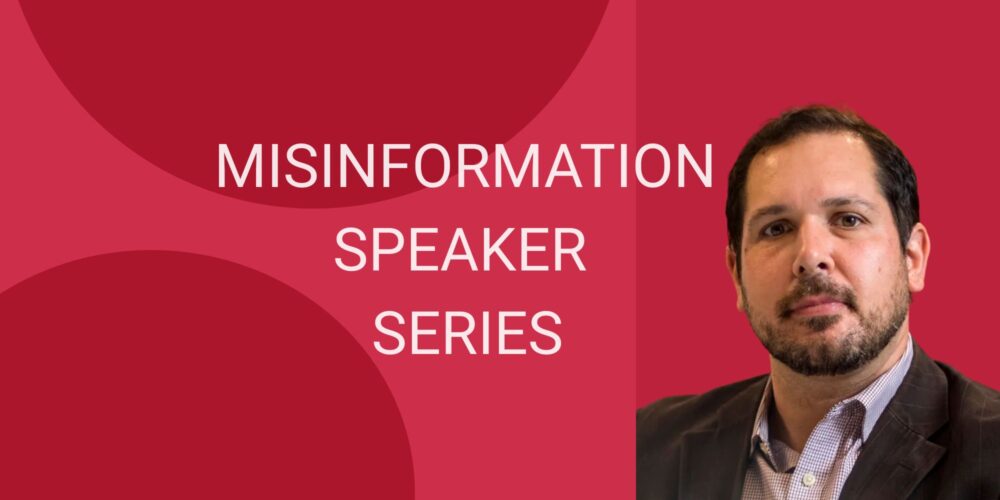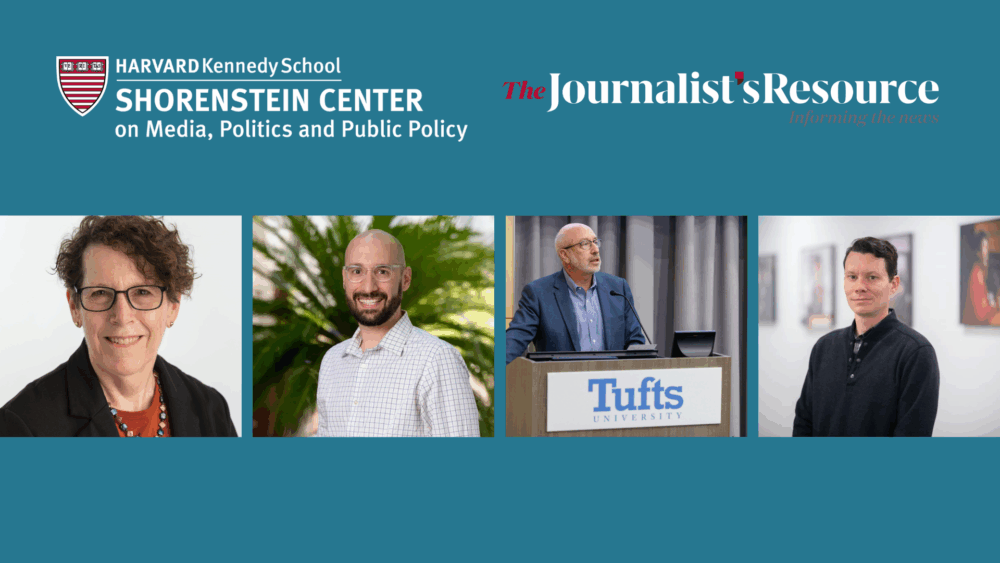
Videos
Regulating Social Media: America’s Global Communications Dilemma
Reports & Papers

A new paper by Claes H. de Vreese, Joan Shorenstein Fellow (fall 2017) and Professor and Chair of Political Communication at the University of Amsterdam, provides an overview of the types and causes of populist movements. He offers 10 tips for how journalists can best cover them. Using scholarly research on populist communication around the globe as a starting point, de Vreese provides guidance to help journalists think about issues such as how much coverage a candidate warrants, covering policy over communication style, and the importance of historical and comparative context.
Listen to de Vreese discuss his paper on our Media & Politics Podcast below. Subscribe to the podcast on iTunes, Google Play, iHeart Radio or Stitcher.
Populist parties have enjoyed increasing electoral success in Western democracies.[1] The average share of the vote for “populist right” parties doubled from 6.7 percent in the 1960s to 13.4 percent in the 2010s, while “populist left” parties’ support rose from 2.4 percent to 12.7 percent in the same period.[2]
Explanations for the rise of populist parties have centered on economic insecurity and cultural disruption—the deepest economic recession in nearly a century, a widening gap in wealth within and between countries, and increasing numbers of migrants and refugees.[3] Globalization, which embodies many of these trends, has also contributed to the populist surge.[4]
The populist impulse is conditioned by differences in political systems. In proportional representation systems, populist parties have had vote shares too small to make them the governing party, although it’s been theoretically possible for them to be part of a coalition. In first-past-the-post systems, populist parties have also received relatively modest vote shares, although populist actors within a major party—Donald Trump being a prime example—have become part of the power structure.
“There can, at present, be no doubt about the importance of populism. But no one is clear what it is.”[5] That assessment is nearly as accurate today when it comes to the understanding of populism’s importance, but scholars have identified aspects of populism that are analytically useful.
For one thing, populism does not have a “mother ideology,” whether it’s liberalism, socialism, authoritarianism or something else. It can occur at any point on the political spectrum, although it tends to surface on the political fringes, right or left.
Populism has three distinguishing features that, individually or in combination, identifies it.[6] One feature is reference to “the people.” It’s the central element, common to all forms of populism.[7] When it’s the only element, it’s been dubbed empty populism.[8] A second feature is reference to a corrupt elite—an explicit condemnation of the establishment, current power holders, and a dysfunctional system. Anti-elitist populism is the term used for appeals confined to anti-elitism and “the people.” The third feature is out-group exclusion—the delegitimizing of a particular group or groups, such as immigrants. Excluding populism is used to describe messaging based only on “the people” and out-group exclusion. Complete populism is the term used when all three features—“the people,” anti-elitism, and out-group exclusion—are present.
In terms of its impact, there’s a general tendency to see populism as a threat to liberal democracy.[9] Populism might curb minority rights. Populism might exploit an electoral mandate to undermine core institutions like the courts or the news media. Populism might lead to a political tribalism that inflames divisions, blunts civil discourse, and eschews political compromise.
But that’s clearly not the full range of possibilities. Populism might give voice to groups of citizens who feel elites are inattentive to their interests. Populism might give rise to legitimate issues that are being underplayed by the mainstream press. Populism might mobilize people who have not been politically involved. Populism might force political parties and leaders to tie their agendas more closely to popular opinion. Populism might serve as a wake-up call to the self-serving actions of powerful elites.
Scholarly assessments of populism’s effects are typically of the “it depends” variety, seeing populism as both a threat to and corrective of conventional democratic practices.[10]
Not enough attention has been given to populism as a communication phenomenon. Political scientists have focused on the political, social, and economic drivers of populism, with only minor attention to the communication elements of populism.[11] Most of what is assumed about populist communication is a side note to studies of voting, particularly right-wing voting. As one group of scholars concluded: “Most of the assumptions about who is affected, why they are affected and by what kinds of message elements do not come from systematic studies.”[12]
Scholars’ inattention to populist communication is rather surprising given the changing media landscape and the communication opportunities it offers non-mainstream political actors.[13] As one scholar put it, “populism is particularly suited to the contours of the new media galaxy.’’[14] We’ve seen confirmation of that proposition recently in Switzerland, the Netherlands, Hungary, and Italy.[15]
The relationship between populist communicators and the media has typically been strained. On the one hand, populist actors often receive critical coverage in the mainstream press,[16] and the news media are typically portrayed by populist actors as part of the “corrupt” elite. On the other hand, populist actors need the “oxygen of publicity” that the news media can provide. The news media are important in terms of disseminating their messages and increasing their visibility and legitimacy.[17] Journalists have been responsive in many instances; news coverage of populist actors has been on the rise.[18] In some cases, as with Wilders in the Netherlands and Trump in the United States, populist actors have even had some success in setting the mainstream news media’s agenda.[19]
Media systems differ in the attention that populist communication is likely to receive.[20] Although all systems have news outlets that compete broadly for audience, some systems have partisan outlets that favor particular parties, which can be less open to giving voice to populist communication. Additionally, some media systems have regulations about access and balance that affect how much attention such communication receives.[21]
Nevertheless, it’s an open question as to whether populist actors receive disproportionate coverage, either too much or too little, relative to comparable actors.[22] What’s clear is that the recent populist surge has prompted self-reflection on the part of news outlets and journalists about their coverage of populist actors.[23] This tendency was particularly pronounced among British journalists in the wake of their Brexit referendum coverage and American journalists in light of their coverage of Trump’s presidential campaign. The question is a difficult one, and the answers will undoubtedly vary across political and media systems, and even for different news outlets within the same media system.
That said, the following are coverage suggestions based on what’s known from scholarly research about populist communication:
Journalism is being challenged at a level unprecedented in its history. The content and authority of traditional news outlets are being questioned, and their monopoly on people’s attention has been lost to new platforms and communicators. The rise of populist politics is yet another challenge, accompanied as it is in some cases by actors hostile to journalists and even to the idea of press freedom. Yet, as with the other challenges, the rise of populist politics reminds us why we need journalists, and why we need them to do their job effectively.
[1] The author would like to thank the leaders and members of the EU Cost Action on populist communication (http://populistcommunication.eu) for shaping his thinking about populist communication. He would also like to thank his 2017 Fall Shorenstein Center Fellow cohort and the Shorenstein Center faculty and staff for providing a stimulating, engaging, and fun environment to complete this paper. Special thanks to Thomas E. Patterson for his insights and suggestions. Elements of the paper will be included in an Introduction to a Special Issue on populist communication of the International Journal of Press/Politics.
[2] Inglehart, R. F., & Norris, P. (2016, September). Trump, Brexit, and the rise of populism: Economic have-nots and cultural backlash. Paper presented at the annual meeting of the American Political Science Association, Philadelphia, p. 23.
[3] See also van Hauwaert, S. M. & van Kessel, S. (2017). Beyond protest and discontent: A cross-national analysis if the effect of populist attitudes and issue positions on populist party support. European Journal of Political Research, online first; Lacau, E. (2005). On populist reason. London: Verso.
[4] Kübler, D., & Kriesi, H. (2017). How globalisation and mediatisation challenge our democracies. Swiss Political Science Review, 23(3), 231–245. doi:10.1111/spsr.12265
[5] This quote stems from a publication from a conference held in 1967 at the London School of Economics (LSE) on the meaning and characteristics of populism. The conference publication is referenced in Moffitt (2016, p. 14): Moffitt, B. (2016). The global rise of populism: Performance, political style, and representation. Stanford: Stanford University Press.
[6] Jagers, J., & Walgrave, S. (2007). Populism as political communication style: An empirical study of political parties’ discourse in Belgium. European Journal of Political Research, 46(3), 319–345. doi:10.1111/j.1475-6765.2006.00690.x; Mudde, C. (2004). The populist Zeitgeist. Government and opposition, 39(4), 541–563. doi:10.1111/j.1477-7053.2004.00135.x; Kriesi, H. (2014). The populist challenge. West European Politics, 37(2), 361–378. doi:10.1080/01402382.2014.887879; Aalberg, T., & de Vreese C. H. (2017). Comprehending populist political communication. In T. Aalberg, F. Esser, C. Reinemann, J. Strömbäck & C. H. de Vreese (Eds.), Populist political communication in Europe (pp. 3–11). New York: Routledge.
[7] Laclau, E. (2005). On populist reason. London: Verso, p. 169
[8] Jagers & Walgrave 2006
[9] Mudde, C., & Kaltwasser, C. R. (2017). Populism: A very short introduction. New York, NY: Oxford University Press.
[10] Mudde, C., & Kaltwasser, C. R. (2012). What is populism? In C. Mudde & C. R. Kaltwasser (Eds.), Populism in Europe and the Americas: Threat or corrective for democracy? (pp. 1–20). New York, NY: Cambridge University Press.
[11] Aalberg et al., 2017
[12] Reinemann, C., Matthes, J., & Sheafer, T. (2017). Citizens and populist political communication: Cross-national findings and perspectives. In T. Aalberg, F. Esser, C. Reinemann, J. Strömbäck & C. H. de Vreese (Eds.), Populist political communication in Europe (pp. 381–394). New York: Routledge.
[13] Chadwick, A. (2014). The hybrid media system: Politics and power. Public Administration, 92(4), 1106–1114. doi:10.1111/padm.12108; van Aelst, P., Strömbäck, J., Aalberg, T., Esser, F., de Vreese, C. H., Matthes, J., … & Papathanassopoulos, S. (2017). Political communication in a high-choice media environment: A challenge for democracy? Annals of the International Communication Association, 41(1), 3–27. doi:10.1080/23808985.2017.1288551; (Van Aelst et al., 2017); Zuiderveen Borghesius, F. J., Trilling, D., Moeller, J., Bodó, B., de Vreese, C. H., & Helberger, N. (2016). Should we worry about filter bubbles? Internet Policy Review, 5(1), 1–16. doi:10.14763/2016.1.401; Shah, D. V., McLeod, D. M., Rojas, H., Cho, J., Wagner, M. W., & Friedland, L. A. (2017). Revising the communication mediation model for a new political communication ecology. Human Communication Research, 43(4), 491–504. doi:10.1111/hcre.12115; Stroud, N. J. (2008). Media use and political predispositions: Revisiting the concept of selective exposure. Political Behavior, 30(3), 341–366. doi:10.1007/s11109-007-9050-9).
[14] Keane, J. (2013). Democracy and media decadence. New York: Cambridge University Press.
[15] Ernst, N., Engesser, S., & Esser, F. (2017). Bipolar populism? The use of anti‐elitism and people‐centrism by Swiss parties on social media. Swiss Political Science Review, 23(3), 253–261. doi:10.1111/spsr.12264; Hameleers, M., Bos, L., & de Vreese, C. H. (2016). “They did it”: The effects of emotionalized blame attribution in populist communication. Communication Research, 44(6), 870–900. doi:10.1177/0093650216644026; Moffitt, 2016).
[16] Mazzoleni, G., Stewart, J., & Horsfield, B. (2003). The media and neo-populism: A contemporary comparative analysis. Westport: Greenwood Publishing Group.
[17] Mazzoleni, G. (2008). Populism and the Media. In D. Albertazzi & D. McDonnell (Eds.), Twenty-first century populism: The spectre of Western European democracy (pp. 49–64). Basingstoke: Palgrave Macmillan.
[18] Esser, F., Stępińska, A., & Hopmann, D. (2017). Populism and the media: Cross-national findings and perspectives. In T. Aalberg, F. Esser, C. Reinemann, J. Strömbäck & C. H. de Vreese (Eds.), Populist Political Communication in Europe (pp. 365–380). New York: Routledge
[19] Karpf, D. (2017). Digital politics after Trump. Annals of the International Communication Association, 41(2), 198–207. doi:10.1080/23808985.2017.1316675; Patterson, T. (2017). News coverage of Donald Trump’s first 100 days. https://shorensteincenter.org/news-coverage-donald-trumps-first-100-days/
[20] Hallin, D. & Mancini, P (2017). Ten years after Comparing Media Systems: What have we learned? Political Communication, 34(2), 155-171.
[21] de Vreese, C. H. (2010). Campaign communication and the media. In L. LeDuc, R.G. Niemi & P. Norris (Eds) Comparing Democracies 3 (pp. 118-140). London: Sage.
[22] Bos, L., van der Brug, W., & de Vreese, C. H. (2011). How the media shape perceptions of right-wing populist leaders. Political Communication, 28(2), 182–206. doi:10.1080/10584609.2011.564605
[23] Amanpour, C. (2016, November 23). Journalism faces an ‘existential crisis’ in Trump era. CNN. Retrieved from http://www.cnn.com/2016/11/23/opinions/christiane-amanpour-journalism-in-trump-era/; Carlson, M. (2016). Metajournalistic discourse and the meanings of journalism: Definitional control, boundary work, and legitimation. Communication Theory, 26(4), 349–368. doi:10.1111/comt.12088; Dawes, N. (2016, November 22). Maneuvering a new reality for US journalism. Columbia Journalism Review. Retrieved from https://www.cjr.org/the_feature/trump_journalism_press_freedom_global.php; Lawrence, R. G., & Boydstun, A. E. (2017). What we should really be asking about media attention to Trump. Political Communication, 34(1), 150–153. doi:10.1080/10584609.2016.1262700; Patterson, T. E. (2016, July 11). News coverage of the 2016 presidential primaries: Horse race reporting has consequences. Shorenstein Center. Retrieved from https://shorensteincenter.org/news-coverage-2016-presidential-primaries
[24] van Spanje, J (2017). Controlling the electoral marketplace. Springer.
[25] Coffé, H., Heyndels, B., & Vermeir, J. (2007). Fertile grounds for extreme right-wing parties: Explaining the Vlaams Blok’s electoral success. Electoral Studies, 26.
[26] Picard (2016). Journalism, populism and the future of democracy. Keynote, Dortmund, October, 2016.
[27] De Vreese, C. H., Esser, F. & Hopmann, D. (2016). Comparing Political Journalism. Routledge: London.
[28] Patterson, T. (1993). Out of Order. New York: Vintage; Cappella, J., & Jamieson, K.H. (1997). Spiral of Cynicism. Oxford: Oxford University Press.
[29] Patterson, 1993; 2016; Cappella & Jamieson, 1997
[30] Esser, F. & D’Angelo, P. (2006). Framing the press and publicity process in US, British, and German election campaigns. International Journal of Press/Politics, 11(3), 44-66.
[31] de Vreese, C. H., & Elenbaas, M. (2008). Media in the game of politics: Effects of strategic metacoverage on political cynicism. International Journal of Press/Politics, 13(3), 285–309. doi:10.1177/1940161208319650.
[32] Chadwick, 2014
[33] Graham, T., Jackson, D., & Broersma, M. (2014). New platform, old habits? Candidates’ use of Twitter during the 2010 British and Dutch general election campaigns. New Media & Society, 18 (5), 765-783.
[34] Blanquart, G. & Cook, D. (2016). Twitter influence and cumulative perceptions of extremist support: A case study of Geert Wilders. http://ro.ecu.edu.au/act/22/
[35] Wardle, C. & Derakhshan, H. (2017). Information disorder: Toward an interdisciplinary framework for research and policy making. Report to the Council of Europe. https://shorensteincenter.org/information-disorder-framework-for-research-and-policymaking/
[36] Nyhan, B. & Reifler, J. (2010). When corrections fail: the persistence of political misperceptions. Political Behavior, 32(2), 303-330.
[37] Thorson, E. (2016). Belief echoes: The persistent effects of misinformation. Political Communication, 33(3), 460-480.
[38] Bode, L. & Vraga, E. (2015). In related new, that was wrong: The correction of misinformation through related stories functionality in social media. Journal of Communication, 54(4), 619-638.
[39] Amanpour, 2016
[40] e.g. Howard, P. N., Bolsover, G., Kollanyi, B., Bradshaw, S., & Neudert, L. M. (2017). Junk news and bots during the US election: What were Michigan voters sharing over Twitter? (Data memo 2017.1). Retrieved from http://comprop.oii.ox.ac.uk/wp-content/uploads/sites/89/2017/03/What-Were-Michigan-Voters-Sharing-Over-Twitter-v2.pdf
[41] Schudson, M. (1995). The Power of News. Cambridge: Harvard University Press.
[42] Hanitszch, T., van Dalen, A., & Steindl, N. (2017). Caught in the Nexus: A Comparative and Longitudinal Analysis of Public Trust in the Press. International Journal of Press/Politics, online first: http://journals.sagepub.com/doi/abs/10.1177/1940161217740695#articleShareContainer

Videos

Explainers, Podcasts, Videos

Videos